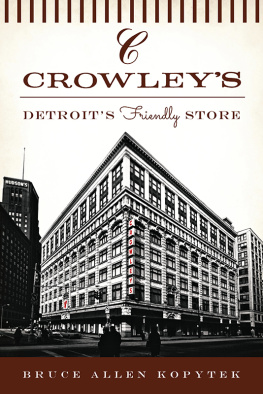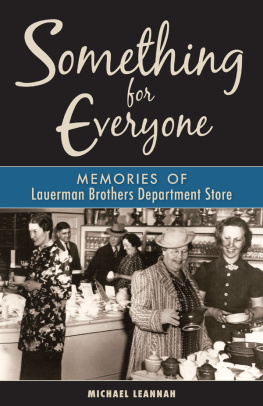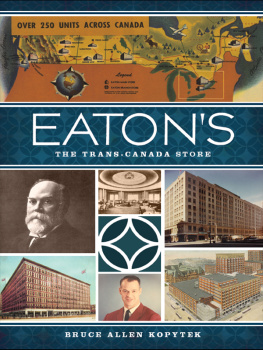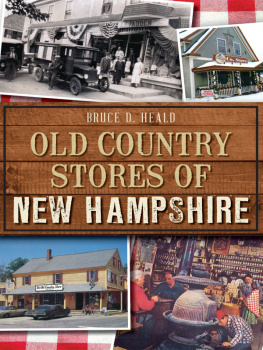


Published by The History Press
Charleston, SC
www.historypress.net
Copyright 2015 by Bruce Allen Kopytek
All rights reserved
Cover images courtesy of the author.
First published 2015
e-book edition 2015
ISBN 978.1.62585.758.3
Library of Congress Control Number: 2015953416
print edition ISBN 978.1.46711.974.0
Notice: The information in this book is true and complete to the best of our knowledge. It is offered without guarantee on the part of the author or The History Press. The author and The History Press disclaim all liability in connection with the use of this book.
All rights reserved. No part of this book may be reproduced or transmitted in any form whatsoever without prior written permission from the publisher except in the case of brief quotations embodied in critical articles and reviews.
Dedicated to my sister, Mary Eve Klamo, and my brother, Patrick Joseph Kopytekwho grew up with me in our Detroit.
CONTENTS
ACKNOWLEDGEMENTS
Given the lack of specific archives, and the fact that Crowleys disappeared over fifteen years ago, it was clear to me that a book dedicated to the store would require the cooperation of many people from many walks of life. An author with a particular historical interest begins his work without much more than a few memories and perhaps a set of preconceived ideas that must be either confirmed or disproven. When traditional research sources prove inconclusive or nonexistent, a plea goes out, and an author hopes for help. In the case of Crowleys: Detroits Friendly Store, I was assisted by the knowledge, collections and sheer kindness of the following people.
The first proof that I would not work alone came from Carl Katafiasz of the Livonia Public Library, who saved me a trip across town in Detroits traffic by sending local newspaper articles about Crowleys 1964 opening. Actually, my best librarian award with regard to this book is a tie; it also goes to Josh Rouan of the Birmingham Baldwin Library, who likewise supplied me with information it would have otherwise taken days to retrieve. Author Michael Hauser proved to be a great support throughout the development of this book, not just by loaning a whole box full of Crowley memorabilia but also by verifying facts and offering support and numerous suggestions along the way. Likewise, department store historian Kevin Kiepert supplied me with a great deal of background information about Crowleys and Demerys that proved indispensable. Local historian and former Oak Park mayor Jerry Naftaly lent valuable assistance as well. Historian and author Dan Austin, who created the magnificent Historic Detroit website, was able to get me access to photographs otherwise unavailable for use and posted a plea for information about Crowleys on his blog. Without any of these people, let me be clear: this book could not exist.
Others who helped deserve the readers gratitude, as well as mine. Marcy Goldstein of JGA Architects enthusiastically procured images from her employers archives for my use; Dan Redstone of Redstone Associates opened up the world of his famous firms photos for my use; and Sue Brooks of the Smith Group (successor architecture firm to Detroits Smith, Hinchman & Grylls) helped me find information about the building the firm designed for Pardridge & Blackwell and, ultimately, Crowleys. I am also grateful to the Detroit Historical Society and the Manning Brothers Historical Photo Collection for their assistance.
With regard to pictures, I am indebted to Mike Grobbel, who rescued an anonymous box of slides, posted his scans of photos of Crowleys online and was more than willing to let me use the treasure he saved. Thanks go to author Michael Lisicky for the use of his photos as well.
Jack Butler of Chicago and his Detroit-area brother, Keith, enthusiastically answered my call for some information about the store their father owned from 1955 to 1972: Demerys. The book would be lacking good pictures of this part of Crowleys history without their help.
A snowy Sunday afternoon spent over coffee with Steve Kennedy gave me more than insight into Crowleys for the book; it also gave me a peek into the life of this extraordinary man who lived behind the scenes at Detroits Friendly Store. I am full of gratitude for the generous amount of time he has shared with me. Norine Blake, likewise, enthusiastically shared her Crowleys stories with me and allowed me into her home to talk about the store. At the last minute, Leigh Morrison, the only Crowley family member able to assist with this book, came to my rescue to fill in some facts and offer insight.
Lastly, I must mention my deeply felt appreciation for my lovely wife, Carole, for putting up with my obsession with the story of Crowley, Milner & Co.; for her proofreading skills; her continuous encouragement; and, most of all, her love, affection and understanding.
MY DETROIT
I can never go back to my Detroit, thats for sure. It doesnt exist anymore, and as time goes by, even the tiniest vestiges of it seem to have vanished at an alarming rate. Only my own memories of my Detroit exist, just like someones memories of old Berlin before it was bombed into oblivion or ancient Rome before it was ransacked by barbarians.
My Detroit thrives in my mind as I reminisce about the past, but even these memories soften and lose focus after so many years. My Detroit might have been like the Detroit that others recall, but they, too, can never return to it physically because it simply isnt there any longer. For some, the Detroit they call theirs (like the one I call mine) is too difficult to visit even in the vast world of memory. It can be painful to recall a place that is gone forever. Some even deny that it ever existed at all, claiming that it was nothing more tangible than a mirage on a hot, desert-like day. Still others reminisce more happily, stoically admonishing the old saying Nothing good lasts forever.
How did my Detroit look? My Detroit wasnt a city cut into isolated pieces by the broad, vacant swaths of expressways (though they were being conceived and built at the time). It wasnt a city of glassy, outrageous or jagged-shaped buildings. It wasnt even so tall that it inhabited the record books, at least during my lifetime. It was a city of smooth, honed corners and worn bricks. It was old (in reality, Old World) but with a charm that is perhaps its most tragically forgotten aspect; indeed, it is this elusive charm that refuses to surface in any clarity, no matter how hard memory tries to conjure it. It is the charm of little corners, interesting perspectives and burnished images rendered in deep, rich colors placed between the blue of the sky and the varied, Ireland-like greens that covered the earth in my Detroit.
Because I was a young one when I inhabited my Detroit, it seemed like the center of the world. Even after traveling to places much bigger and more important, it was always possible to compare them favorably with the town described by pop radio jingles as the Motor City. It had a river (boy, did it ever!); it had skyscrapersthe Penobscot Building being the tallest, which I learned to recognize after my mother pointed out the illuminated red ball surmounting a conical tower at its peak. It had a palatial city hall and courthouse, and almost more importantly, it had what we now call infill. This infill didnt look too important, yet it provided a place for life to exist between all of these monuments. Look at pictures of my Detroit (if you can find them) and you will not see isolated buildings surrounded by parking lots, puddled by the most recent rainfall and strewn with shards of broken glass. Instead, little, old and even shabby buildings formed edges, or walls, that defined streets and connected various landmarks. I almost forgot to add that in between those important and not-so-important landmarks were the numerous leafy green spaces up to which the streets led.
Next page











